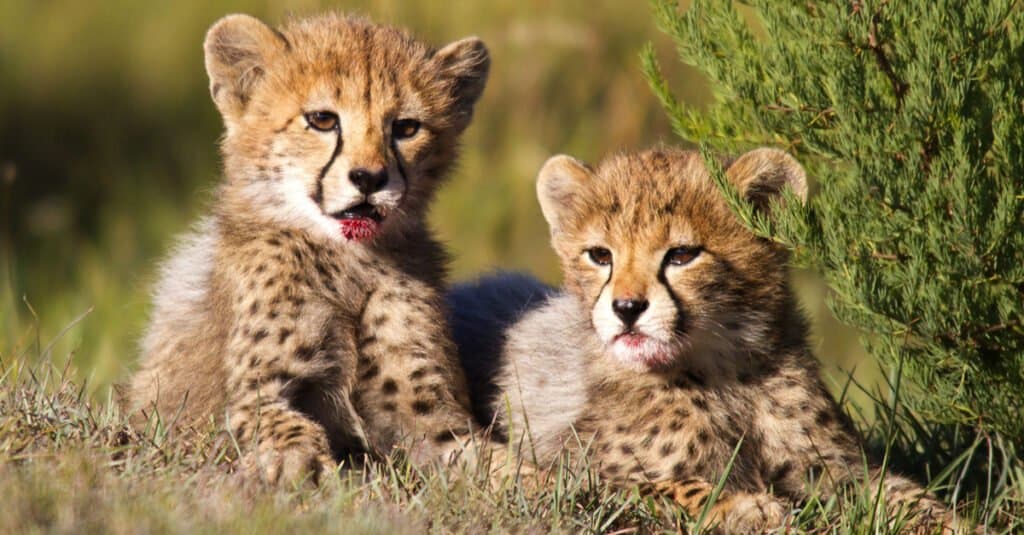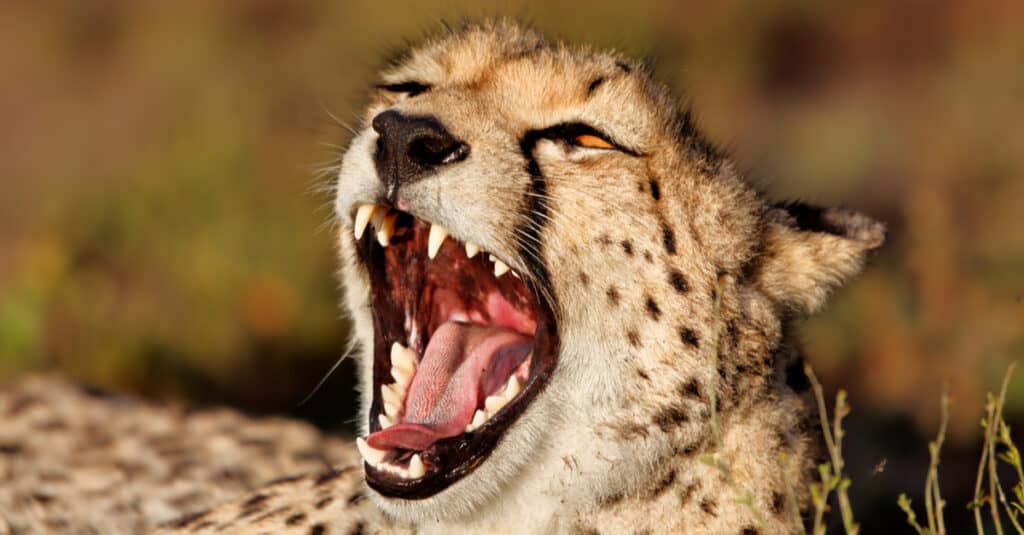The cheetah is a large and powerful feline that was once found throughout Africa and Asia and even in parts of Europe. Cheetahs are one of Africa’s most potent predators and, despite not being classified as a member of the “big cat” family since they cannot roar, they are most known for their incredible speed during pursuits, reaching speeds of more than 60 mph. Additionally, due to human activity, particularly the hunting of cheetahs for their fur, the population of the fastest land animal in the world—the cheetah—has decreased.
In this article, we uncover what features make cheetah teeth special, how many sets they obtain in a lifetime, and what they are used for. We’ll next delve a little deeper into the unique uses of each of their tooth types and find out how powerful a cheetah’s bite actually is!
How To Identify a Cheetah
The body of the cheetah is long and slender, and its coarse, yellowish fur is spotted with tiny black patches. The cheetah’s long tail aids in balance, and unlike the rest of its body, it has ringed markings that finish in a black tip. Additionally, they have recognizable black “tear marks” that extend from the inner corner of their eyes, down their noses, and outward to the edges of their mouths that prevent them from becoming blinded by intense light. Their extraordinary speed is due to a variety of factors, including having powerful hind legs and an exceptionally flexible and muscular spine that helps them to sprint swiftly and also makes them very agile.
Are Cheetahs Born With Teeth?

Francois van Heerden/Shutterstock.com
It is worth noting that cheetahs are mammals, and as such, they give birth to their young alive. Cheetah cubs are born blind and mostly helpless, but they are known to have a very rapid growth rate; within ten days of birth, their eyes open, and they begin crawling around the nest area. Also, by the time they turn three weeks old, their milk teeth start to show. Despite this, baby cheetahs only consume their mother’s milk for the first three months of their life.
Cheetah cubs grow rapidly and reach half their adult size at six months of age, and by this time, their mothers waste no time and start teaching them how to hunt. However, even before they turn six months, some baby cheetahs begin to eat small pieces of meat from their mother. The earliest time they can start eating small meat pieces is at three months of age. By the time they reach the eighth-month mark, most cheetah cubs would have lost the last of their milk teeth and have become their own sole providers, going out to hunt for their own food.
Adult Cheetah Teeth

Although several species of cheetahs exist, they are all carnivorous. Cheetahs are huge cats with voracious appetites who eat a lot of smaller animals in the wild. Primarily, they eat springbok, impala, and gazelles. They will, however, pursue small creatures like birds and rabbits when food supplies are low. Because of their dietary choices, these big boys have several teeth that serve several functions.
Like most big cats such as the lion, adult cheetahs have 30 teeth- 16 in their upper jaw and 14 in the lower. They have 12 incisors, six on each jaw, four canines, two on each jaw, four molars, two on each jaw, and ten premolars- six on the upper jaw and four on the lower.
Incisors
Cheetahs have 12 incisors evenly distributed among both jaws, like most predatory cats. In the upper jaw, there are six incisors, with the two closest to the canines bigger than the other four. Because of their size, these larger incisors also have some space between them and the canines. Straight and powerful incisors are necessary for easy access to the prey’s flesh. Cheetahs skin carcasses and remove the fur with the aid of their incisors.
Canines
Cheetahs have four strong canines on both the upper and lower jaws, and they use these teeth to grab and hold onto fleeing prey. Cheetahs mostly kill by strangulation or suffocation, and their canine teeth are instrumental in this process as they also use them to suffocate their prey. Because cheetahs are not true big cats, their canines are smaller and less strong than those of other big cats.
Carnassials
For most big cats, their molars and premolars are grouped and called carnassials. Cheetahs have 14 in total- 10 premolars and four molars. These teeth resemble the lion’s and leopard’s blade-like teeth. They function like scissors and allow the cheetah to shear substantial chunks of flesh, which it quickly swallows whole.
How Hard Do Cheetahs Bite?

Maggy Meyer/Shutterstock.com
Cheetahs are three times stronger than humans but weaker than other big cats, with a biting force of roughly 500 PSI and a strike powerful enough to dislodge a warthog or antelope. They make up for their lack of strength with speed and agility.
Cheetahs have weaker jaws and smaller canine teeth than other large cats as a trade-off for having other adaptations required for rapid acceleration to pursue prey, such as a shortened nose and lower skull size.
Are Cheetahs Endangered?
Cheetahs once covered many areas of Africa and Asia, and now, there are barely enough left in the entire world. As established, cheetahs are on the verge of extinction because of certain human activities. According to the IUCN Red List, cheetahs are classified as vulnerable. Cheetahs are unlawfully caught, sold as live animals to the exotic pet trade, and also poached for their skin. They are also unlawfully slaughtered for their claws and teeth.
Up Next:
How Many Cheetahs Are Left In The World?
The post Cheetah Teeth: Everything You Need To Know appeared first on AZ Animals.
from Animal News, Facts, Rankings, and More! - AZ Animals https://ift.tt/6mAdrwZ